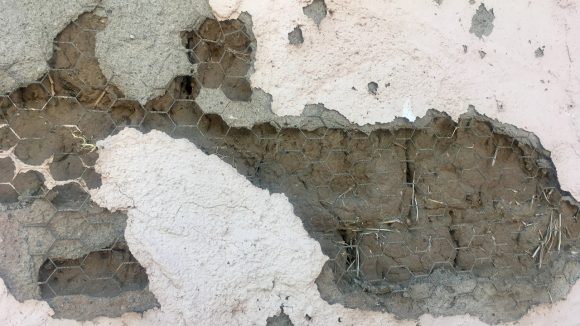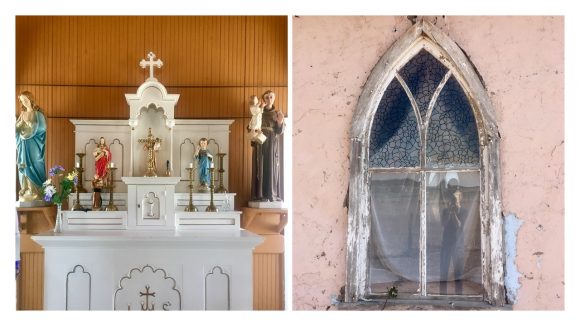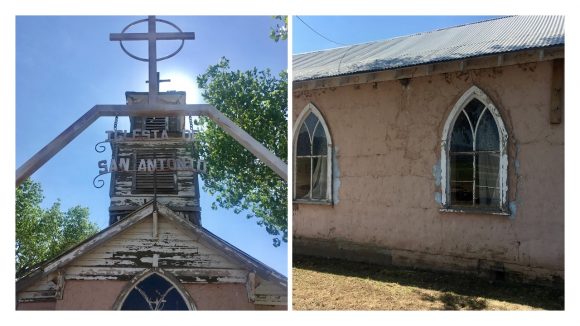Year Listed: 2019
County: La Plata
Construction Date: 1928
Threat When Listed: Demolition by Neglect, Vandalism, Lack of Resources, Weatherization
Status: IN PROGRESS
Video courtesy of CBS4
The small Tiffany Catholic Church, Iglesia de San Antonio, is one of the few remaining historic churches that conveys the story of Hispano history in the area of southeastern La Plata County near the border with New Mexico. The church was constructed in 1928 using using local labor and materials in the settlement of Tiffany, which was established in 1881 as a stop along the Denver & Rio Grande Railroad (D&RG) on the route to Durango. It is a one story building constructed of Adobe bricks and wire and plaster, which is deteriorating but retains a high degree of integrity, including its beautiful interior.

Hispano settlement in the area primarily consisted of farming along riverine lands. The common occupations were small family farms, many with orchards, and sheephearding. Many of these early settlers were migrants from northern New Mexico and the riverine areas along the La Pedra, Los Pinos, and the San Juan Rivers. Completion of the church in 1928 reflected the importance placed on religious and other services to the local community. In 1942, ownership of the church transferred to the Diocese of Pueblo, the current owner. Regular services were held until 1972 but an annual Mass continues to be held in June at the church to honor Saint Anthony, with 85 people packed into the tiny church in 2018. Local Families have long served as loving caretakers for the church, including the Stella Lucero family and the Munoz family.
“Current church members’ ancestors built this church from the earth, forming the adobe block by hand with purpose and reverence. Today local families continue to maintain the church out of love for their religious traditions embodied in the church building”-Ruth E. Lambert, Ph.D -San Juan Mountains Association

The construction style of the church is reminiscent of Territorial Adobe dwellings that were popular in the San Luis valley and the Rosa and Tierra Amarilla areas of New Mexico. The building is a one-story Catholic church oriented to the west. It is rectangular in shape with recessed doors and an enclosed entry porch. The roof is a front gable with exposed rafter tails on the north and south elevations. There is a two-part centered square wooden steeple with a cross at the top. The church is built of adobe bricks with wire and stucco plaster. The exterior has been painted a pale pink with wood trim painted white. The interior of the church is beautiful, with an altar that extends across the width of the church containing all the original altar items, including the collection box, the original cross that is carried into the church at the beginning of mass, and all the original brass candle holders.
Although the church is suffering from deterioration, it retains all the elements of integrity; it is original with no additions, alterations, or replacement of original materials. There is broad support across the county for rehabilitation of the church. The local historical societies and the La Plata County Historic Preservation Review Commission are supportive of efforts to rehabilitate the church and members of the La Plata County Commission also support the repairs to the church. By working with the local caretaker families and these groups in the area to preserve the church, CPI honors the heritage of hard-working Hispano families and their contributions to Colorado history.
Since its listing, the interior of the church has been painted and continues to be maintained by local families for the annual mass. A chain link fence was installed around the perimeter of the property to keep neighboring animals from damaging the building. Technical staff from the State Historical Fund and an architect from Durango completed an initial preliminary building assessment. CPI worked with the San Juan Mountains Association to complete a State Historical Fund mini-grant for construction documents, stabilization work, and stucco repairs in 2021. CPI prioritized the church as one of five key EPP sites in 2022 and hopes to raise matching funds and apply for a full SHF grant in the coming year.




